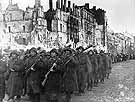
|
|
|

|

|

|

|
|
Click on an image to see a larger, more detailed picture.
|
|
|
|
|
| 1945: Liberation and Rebuilding |

|
pg. 583 |

|
|
|
|
| |
 Soviet troops march through the ruins of Warsaw in January 1945. Little survived of Jewish Warsaw, and few survived to rebuild what had once been a flourishing Jewish community. From the rubble, some Jews emerged from hiding, their joy mixed with anguish over the loss of so many loved ones.
Soviet troops march through the ruins of Warsaw in January 1945. Little survived of Jewish Warsaw, and few survived to rebuild what had once been a flourishing Jewish community. From the rubble, some Jews emerged from hiding, their joy mixed with anguish over the loss of so many loved ones.
Photo: Ullstein Bilderdienst
|
 By the time Czestochowa, Poland, was liberated by the Red Army in January 1945, what was once a thickly populated ghetto had been nearly eradicated by fleeing Nazis. Not long before this January photo of Soviet soldiers posing with a few of the town's 5000 Jewish survivors, many Jews in the area had perished from a typhus epidemic, been shipped to their deaths at Buchenwald and Ravensbrück, or been sent as slaves to HASAG Pelzery, a nearby munitions factory.
By the time Czestochowa, Poland, was liberated by the Red Army in January 1945, what was once a thickly populated ghetto had been nearly eradicated by fleeing Nazis. Not long before this January photo of Soviet soldiers posing with a few of the town's 5000 Jewish survivors, many Jews in the area had perished from a typhus epidemic, been shipped to their deaths at Buchenwald and Ravensbrück, or been sent as slaves to HASAG Pelzery, a nearby munitions factory.
Photo: Jack Shipper/United States Holocaust Memorial Museum Photo Archive
|
 Zivia Lubetkin
Zivia Lubetkin
A true heroine of the Resistance, Zivia Lubetkin fought valiantly in the Warsaw Ghetto revolt. Only after the Germans set the ghetto afire in May 1943 did she flee through the sewers to the "Aryan" side of Warsaw, having fulfilled her vow to remain to the end. An activist in the Zionist youth movement before the war, Lubetkin represented the Dror He-Halutz party in the Antifascist Bloc, formed in 1942 to battle the Nazis and support the Soviet Army. The next year she joined with Yitzhak Zuckerman, whom she would marry after the war, and others to found the Zydowska Organizacja Bojowa (ZOB; Jewish Fighting Organization). Hidden by a physician after the fall of the ghetto, Lubetkin witnessed the relief that accompanied the arrival of Soviet forces on January 17, 1945. She recounts that she and her comrades nevertheless remained "crushed and dejected," knowing that few Jews had lived to witness this day.
Photo: Yad Vashem / United States Holocaust Memorial Museum Photo Archive
|
|

|

|

|

|
 January 1945: Helmuth James Graf von Moltke, an anti-Nazi Resistance leader and former legal advisor to the German High Command, is executed at the Plötzensee Prison in Berlin.
January 1945: Helmuth James Graf von Moltke, an anti-Nazi Resistance leader and former legal advisor to the German High Command, is executed at the Plötzensee Prison in Berlin.
|
 January 1945: The Central Registry of War Criminals and Security Suspects (CROWCASS), an inter-Allied investigative group, is created by the Supreme Headquarters, Allied Expeditionary Force (SHAEF). Its mission is to identify and prosecute Nazi war criminals.
January 1945: The Central Registry of War Criminals and Security Suspects (CROWCASS), an inter-Allied investigative group, is created by the Supreme Headquarters, Allied Expeditionary Force (SHAEF). Its mission is to identify and prosecute Nazi war criminals.
|
 January-March 1945: 2163 Spanish Republicans, who had fought against Nazi-backed forces during the Spanish Civil War, are worked to death or murdered outright at stone quarries at the Mauthausen, Austria, labor camp.
January-March 1945: 2163 Spanish Republicans, who had fought against Nazi-backed forces during the Spanish Civil War, are worked to death or murdered outright at stone quarries at the Mauthausen, Austria, labor camp.
|
 January 1-16, 1945: The leading edge of the German Ardennes offensive is halted by the Allies, ending the so-called Battle of the Bulge, the last great German offensive of the war.
January 1-16, 1945: The leading edge of the German Ardennes offensive is halted by the Allies, ending the so-called Battle of the Bulge, the last great German offensive of the war.
|
|
|
|
|
| 1945: Liberation and Rebuilding |

|
pg. 583 |

|
|
The Holocaust Chronicle
© 2009 Publications International, Ltd.
|
|
